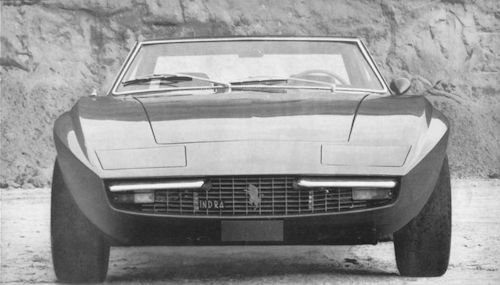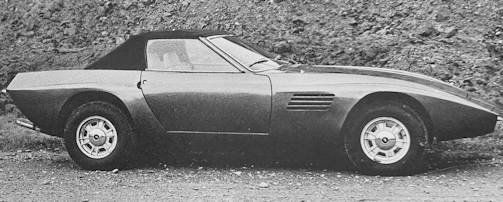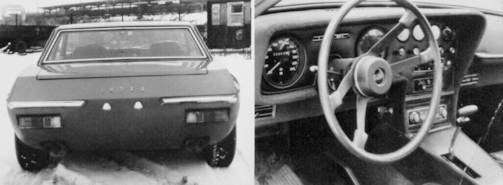Intermeccanica Indra
 |
|
|
Production period: |
1971 to 1975 |
|
Class : |
sports car |
|
Body versions : |
Coupe , convertible spider |
|
Engines: |
Gasoline : 2.8-5.7 liters |
|
Length: |
176.38 in, 4,480 mm |
|
Width: |
70.47 in, 1,790 mm |
|
Height: |
46.46 in, 1,180 mm |
|
Wheelbase : |
98.43 in, 2,500 mm |
|
Curb weight : |
2,536 1b, 1,150 kg V8: 2,844 1b 1,290 kg. |
The Intermeccanica Indra was a sports car of the Italian car manufacturer Costruzione Automobili Intermeccanica , which was manufactured between spring 1971 and early 1975 in Turin .
History
The Indra was designed by Franco Scaglione and constructed by Erich Bitter . Like its predecessor, the Intermeccanica Italia , the Indra had a European-designed sports car body, which was associated with American drive technology from mass production The Austrian engineer Friedrich "Fritz" Indra while driving a Indra himself, but was not involved in the development, as is sometimes claimed. Depending on the source, the model name can be traced back to the Hindu goddess Indra.
Erich Bitter mediated in the course of 1970, a contact between Intermeccanica and General Motors . A short time later, the decision was made not to use components from Ford USA for the new Intermeccanica model , but to use the drive technology of the Diplomat V8 , the largest and most expensive vehicle from General Motors of European production. At the same time, General Motors was to organize the distribution of wagons in Europe via its Opel dealers. The agreement was similar to the agreement de Tomaso had with Ford for the production and distribution of de Tomaso Pantera .

The connection with General Motors was beneficial for Intermeccanica. The drive technology of the Diplomat - and in particular its 5.4-liter eight-cylinder engine - was based essentially on American designs. As a result, Intermeccanica still had simple and robust engines, which were now also easily and quickly available in Europe - through Opel dealers. Finally, Opel's large dealer network ensured secured maintenance.
PERFORMANCE: 2,784 cc 6 cylinders
- Max speed: over 130 mph, 210 km/h
- Max power (DIN): 190 hp at 6.200 rpm
- Max torque (DIN): 204 1b ft. 28.2 kg m at 4,500 rpm 68.2 hp/l
- Power-weight ratio: 13.2 lb/hp, 6 kg/hp
- Fuel consumption: 23.7 m/ imp gal, 19.8 m/ US gal
PERFORMANCE: 5,354 cc 8 cylinders
- Max power (DIN) 250 hp at 5,000 rpm
- Max torque (DIN) 322 1b ft, 44.5 kg m at 3,400 rpm 46.7 hp/l
- Max speed over 155 mph, 250 km/h
- Power-weight ratio 11.5 lb/hp, 5.2 kg/hp
- Fuel consumption 19.1 m/imp gal, 15.9 m/US gal, 14.8 1 x 100 km.
PERFORMANCE: 5,733 cc 8 cylinders
- max speed: about 162 mph, 260 km/h
- power-weight ratio: 11.9 lb/hp, 5.4 kg/hp
- fuel consumption: 14.1 m/imp gal, 11.8 m/US gal.
- max power (DIN): 280 hp at 5,600 rpm
- max torque (DIN): 301 1b ft, 41.5 kg m at 4,000 rpm 49.1 hp/l
Around this technique, the company developed a largely new chassis. New features included a DeDion rear suspension, four disc brakes and a state-of-the-art automatic transmission from General Motors.
Franco Scaglione once again designed the bodywork. The basic layout of the Italia was preserved: The Indra had a long, sloping bonnet with the engine behind the front axle, a terse passenger compartment with two seats (some with two more emergency seats) and a short tail. The front end was now smoothed: Instead of the recessed round individual headlights of Italia saw a folding headlamp construction. The fenders were noticeably bulging at the front and rear, and there was also a curved line over the rear wheels. The rear bumper was high; the taillights (from the Alfa Romeo Giulia ) were mounted under it. This order cited a corresponding feature of the Lamborghini Islero .

Scaglione designed three body versions:
- a two-seater convertible
- a two-seat notchback coupé with generously glazed roof construction. The coupe was basically a convertible with an attached hardtop .
- With a delay of two years also a hatchback coupe with two full-fledged and two emergency seats. The vehicle's profile bore some resemblance to the Maserati Ghibli , a successful Italian sports car of the late 1960s.
The Intermeccanica Indra was presented to the public at the Geneva Motor Show in March 1971. Immediately after the mat took Intermeccanica to mass production. The vehicles were initially distributed only in Europe. Two years later, the Indra was also presented to the American public at the New York Automobile Show . The car was received there kindly, and contemporary press releases report some orders from American customers.
During 1973, General Motors withdrew from the alliance with Intermeccanica. The reasons for this were problems with the quality of the Italian vehicles, which led to financial burdens in the warranty and repair area. Also in this respect, there is a similarity to the history of Ford with the De Tomaso Pantera . General Motors stopped supplying the company with technical components; In addition, sales through the Opel dealers ended. Even Erich Bitter separated from Intermeccanica. Shortly thereafter, he made a very similarly designed, but produced at Baur in Germany coupe called Bitter CD which was successful in Europe in the 1970s. This project was supported by General Motors.
For Intermeccanica, the separation from General Motors meant the end of Indra production in the medium term. Intermeccanica first tried to obtain the necessary parts from Opel dealers. That was, however, associated with much higher prices. In addition, since the sales was no longer secure, Intermeccanica had to stop the production of sports cars in the winter of 1974/1975, after 125 copies were created.
In 1975, the company stayed afloat with the production of some Jaguar SS100 replicas. At the same time, a few other Indra coupe with drive technology from Ford emerged as prototypes for a second series, the Intermeccanica initially wanted to produce from a new base in San Bernardino in California . One of the vehicles was shipped to California with all its production equipment; However, the project ended before its realization, as the (California) financier retired at short notice. The extent of production of Indras with Ford technology is not unequivocally clarified. The Intermeccanica Enthusiasts Clubspeaks of only two copies, of which only one has reached a running condition; assumes 15 copies that did not go into regular distribution but were auctioned off.
Technical
-
Intermeccanica Indra Technical details and specifications (1971-1975)
ENGINE: 2,784 cc 6 cylinders
Opel, location front
4 stroke; 6 cylinders, In line
Engine capacity: 169.9 cu in, 2,784 cc
bore and stroke: 3.62 x 2.75 in, 92 x 69.8 mm
compression ratio: 10.5:1
cast iron cylinder block and head
7 crankshaft bearings
valves: overhead, thimble tappets
camshafts: 1, overhead
lubrication: gear pump, full flow filter
Bosch electronically-controlled injection system
fuel feed: electric pump
water-cooledENGINE: 5,354 cc 8 cylinders
8 cylinders, Vee-slanted at 90°
Engine capacity: 326.7 cu in, 5,354 cc
bore and stroke: 4 x 3.25 in, 101.6 x 82.5 mm
5 crankshaft bearings
hydraulic tappets
camshafts: 1 at centre of Vee
1 Rochester down-draught 4-barrel carburettor
(Optional) air-conditioning.ENGINE: 5,733 cc 8 cylinders
Engine capacity: 349.8 cu in, 5,733 cc
bore and stroke: 4 x 3.48 in, 101.6 x 88.4 mm
compression ratio: 9:1
1 Holley downdraught 4-barrel carburettor.TRANSMISSION
driving wheels: rear
clutch: single dry plate, hydraulically controlled
gearbox: mechanical; gears: 4
fully synchronized
ratios: 1st 2.200, 2nd 1.640, 3rd 1.270, 4th 1, rev 2.260
(Optional) GM automatic transmission, hydraulic torque converter and planetary gears with 3 ratios (I 2.480, II 1.480, III 1, rev 2.080)
gear lever location: central
final drive: hypoid bevel
axle ratio: 3.890 V8 3.100 Auto 2.730
CHASSIS
semi-integral
front suspension: independent, wishbones, coil springs, anti-roll bar, telescopic dampers
rear suspension: de Dion rigid axle, twin swinging longitudinal trailing arms, wide Vee transverse linkage radius arms, coil springs, anti-roll bar, telescopic dampers.STEERING
recirculating ball
turns lock to lock: 4.
turning circle (between walls): 29.5 ft, 9 m
(Optional) power-assisted steeringBRAKES
disc (front diameter 10.67 in, 271 mm, rear 10.94 in, 278 mm), servo.ELECTRICAL EQUIPMENT
12 V
32 Ah battery
35 A alternator V8 37 A.
Bosch distributor
2 retractable headlampsDIMENSIONS AND WEIGHT
wheel base: 98.43 in, 2,500 mm
tracks: 61.02 in, 1,550 mm front, 61.02 in, 1,550 mm rear
length: 176.38 in, 4,480 mm
width: 70.47 in, 1,790 mm
height: 46.46 in, 1,180 mm
ground clearance: 4.92 in, 125 mm
dry weight: 2,536 1b, 1,150 kg
dry weight V8: 2,844 1b 1,290 kg.version
construction
built
Cabriolet
1971-1974
60
Coupe, 2 seats
1971-1974
40
Hatchback coupe, 2+2 seats
1973-1974
25
Hatchback coupe, 2+2 seats, Ford mechanics
1975
2 or 15
© Motor car History
Service
-
Intermeccanica Indra Maintenance and Service Guide (1971-1975)
Fuel: 100 oct petrol
Greasing: every 6,200 miles, 10,000 km, 3 points
Tyres: 195/70 VR x 14.
Carrying capacity: 904 1b, 410 kg
Fuel tank: 17.6 imp gal, 21.1 US gal,ENGINE: 2,784 cc 6 cylinders
Total oil capacity 7.9 imp pt, 9.5 US pt, 4.5 1
Coolant capacity: 15 Imp pt. 18 US pt, 8.5 1.ENGINE: 5,354 cc 8 cylinders
Lubricating system capacity 9.5 imp pt, 11.4 US pt
Cooling system capacity 28.2 Imp pt. 33.8 US pt, 16 1.© Motor car History
Manuals
-
Intermeccanica Previous 2 / 2 Next
